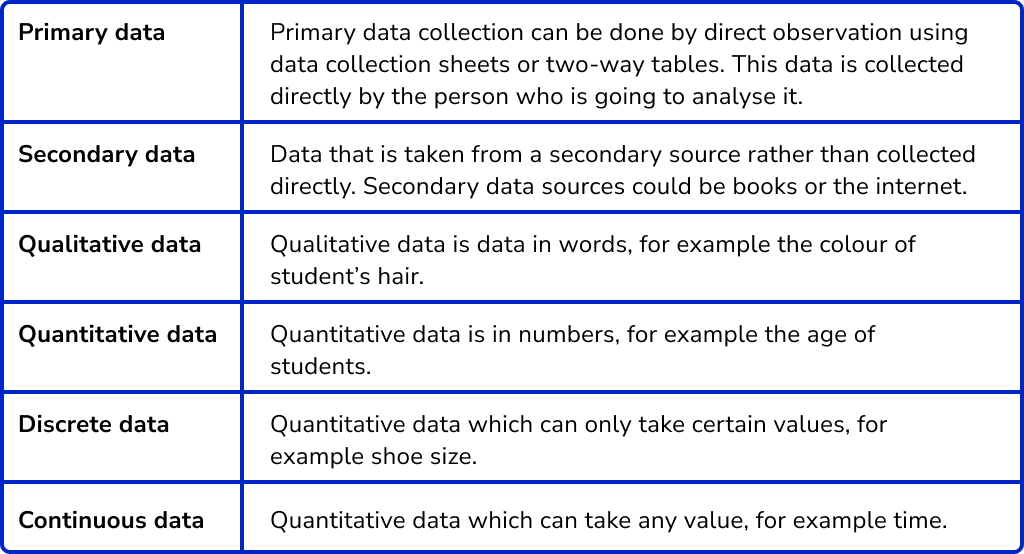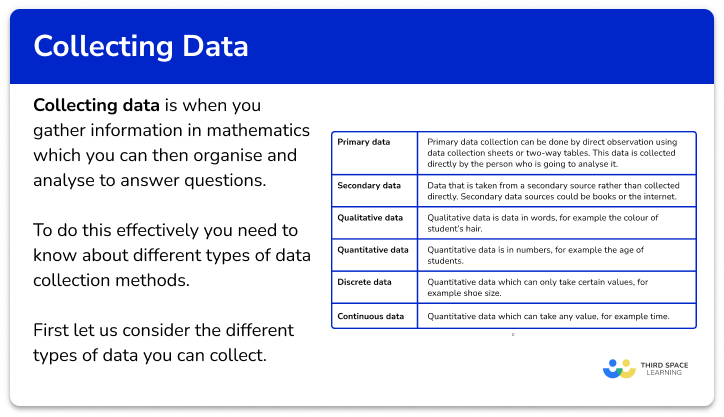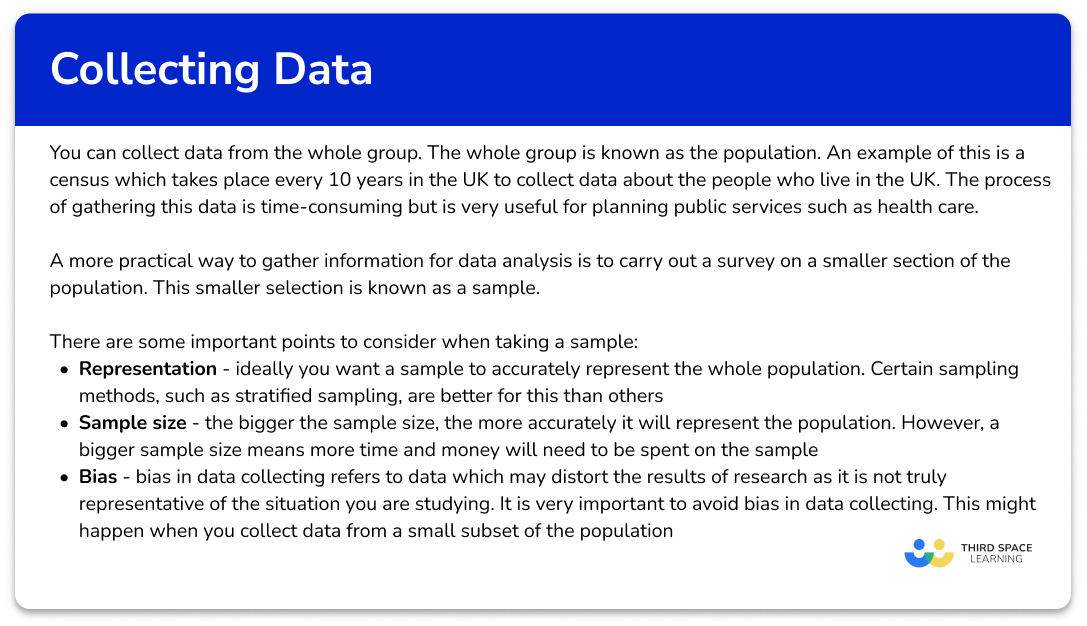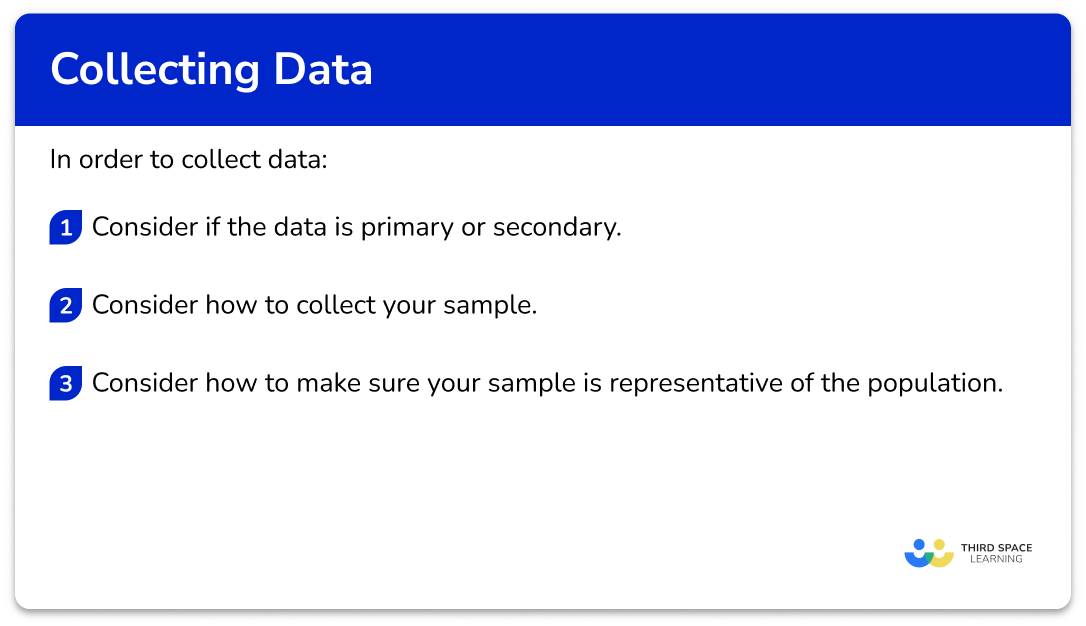GCSE Tutoring Programme
Our chosen students improved 1.19 of a grade on average - 0.45 more than those who didn't have the tutoring.
In order to access this I need to be confident with:
Frequency tables Fractions of amounts Percentage of an amountThis topic is relevant for:

Collecting Data
Here we will learn about collecting data, including different ways to collect data and what important points to consider when you are collecting data.
There are also collecting data worksheets based on Edexcel, AQA and OCR exam questions, along with further guidance on where to go next if you’re still stuck.
What is collecting data?
Collecting data is when you gather information in mathematics which you can then organise and analyse to answer questions.
To do this effectively you need to know about different data collection methods.
First let us consider the different types of data you can collect because these may be asked about in GCSE Mathematics.

You can collect data from the whole group. The whole group is known as the population. An example of this is a census which takes place every 10 years in the UK to collect data about the people who live in the UK. The process of gathering this data is time-consuming but is very useful for planning public services such as health care.
A more practical way to gather information for data analysis is to carry out a survey on a smaller section of the population. This smaller selection is known as a sample.
There are some important points to consider when taking a sample,
- Representation – ideally you want a sample to accurately represent the whole population. Certain sampling methods, such as stratified sampling, are better for this than others.
- Sample size – the bigger the sample size, the more accurately it will represent the population. However, a bigger sample size means more time and money will need to be spent on the sample.
- Bias – bias in data collecting refers to data which may distort the results of research as it is not truly representative of the situation you are studying. It is very important to avoid bias in data collecting. This might happen when you collect data from a small subset of the population.
These concepts will not be examined in GCSE Mathematics, but do feature in A level Mathematics and GCSE Statistics.
Step-by-step guide: Tally charts
What is collecting data?

What is collecting data?

Methodology
A methodology is an explanation of a data collection process. When carrying out research studies, the data collection process can have a significant impact on the data quality. Different methods of data collection have their own advantages and disadvantages.
Each research method must be considered to ensure that the person that is collecting the data (the data processor) can make an informed decision about the method of data collection, to provide high-quality data for their research.
Data collection techniques include,
- Questionnaires (including online surveys)
- Interviews
- Focus groups
- Observations
- Case studies
● Questionnaires and online surveys
A questionnaire or online survey consists of a list of standardised questions about a specific topic. They can be distributed to a large sample of the population and returned to the data processor quickly using data collection tools such as the internet.
Questionnaires are one of the most common types of data collection as they can be cost-effective and, when the questionnaire is well structured, can provide enough detail to satisfy the requirements of the researcher.
Marketing campaigns regularly use the internet, specifically social media to broadcast new ideas and products to the market, often followed up by a questionnaire to provide feedback about the product or service that has been sold.
A questionnaire can contain a mixture of closed and open questions. Closed questions have a fixed response that can be answered by ticking a box or selecting a value on a scale. Closed questions are used to collect quantitative data as you can quickly determine the number of participants that select each option.
For example, the question below is a closed question because the response can only be one of the options provided.

Open-ended questions are used for qualitative research, where the answer to the question is more descriptive and therefore it cannot be answered using a simple tick box.
For example, the question below is an open-ended question because the response is more descriptive.

There are limitations with questionnaires compared to other data gathering methods. One of the main issues is the lack of respondents. Participants in research studies usually need an incentive to complete a questionnaire.
This may take the form of an external motivator such as a discount or free entry into a prize draw, or there could be an intrinsic motivator such as a strong emotional response or feeling of charity. Without incentives, research studies can struggle to collect enough data for their research to be of any significance.
Another limitation of questionnaires and online surveys is the fixed scheme of questions which does not allow participants to elaborate (explain further) on their choice. It is also important that the participant understands the question that is being asked which the data processor cannot check if they are not in attendance when the questionnaire is being answered.
This can lead to unanswered questions or answers that are based on a misinterpretation of the question.
● Interviews and focus groups
Interviews are usually conducted between the researcher and an interviewee. Interviews provide a chance for the interviewee to elaborate on their answers in more detail, which may provide more informative data however interviews are time consuming and are more costly than other qualitative methods of data collection.
Focus groups allow a group of participants to answer questions whilst being able to listen and share ideas with other members within the group. Focus groups are useful as they can be more time efficient and informative compared to other data collection techniques however the dynamics of the individual members of the group can skew the results.
To minimise the risk of a biased data set, the participants should be selected using an appropriate sampling technique. This is important for any research study being carried out.
● Observations and case studies
Participant observation is a useful data collection technique to collect real time qualitative research.
For example,
A social experiment is carried out on a group of 3 year old children into their communication techniques with one another.
By observing their behaviours around each other, researchers can recognise different methods of communication between the children, rather than through difficult processes such as an interview where the children may not understand research questions or may not be able to explain communication techniques with their peers to the research providers.
How to collect data
In order to collect data:
- Consider if the data is primary or secondary.
- Consider how to collect your sample.
- Consider how to make sure your sample is representative of the population.
Explain how to collect data


Types of sampling methods worksheet (includes collecting data)

Get your free collecting data worksheet of 20+ types of sampling methods questions and answers. Includes reasoning and applied questions.
DOWNLOAD FREE
Types of sampling methods worksheet (includes collecting data)

Get your free collecting data worksheet of 20+ types of sampling methods questions and answers. Includes reasoning and applied questions.
DOWNLOAD FREERelated lessons on types of sampling methods
Collecting data is part of our series of lessons to support revision on types of sampling methods. You may find it helpful to start with the main types of sampling methods lesson for a summary of what to expect, or use the step by step guides below for further detail on individual topics. Other lessons in this series include:
Collecting data examples
Example 1: advantages/disadvantages of a census
Write down one advantage and one disadvantage of a census.
A census is a survey of the whole population.
An advantage of this is that the data collected is a very reliable representation of the population.
Disadvantages of this are that it is very time consuming, can be expensive and will produce a large amount of data which can be harder to work with. You could give any one of these as your answer.
Example 2: sample methods
Rob wants to find out how much fast food children eat. He asks 5 of his friends from his class.
Give two criticisms of Rob’s sample.
The things that you need to consider here are whether the sample is representative of the population, whether it is large enough and whether there is any bias.
Criticism 1: A sample of 5 is too small to draw reliable conclusions.
Criticism 2: By asking his friends, he is asking children of the same age who are likely to be quite similar. Therefore the sample will not be representative of all children.
Example 3: improving sample methods
Lydia wants to find out how many pets people have. She asks 50 people in a pet shop how many pets they have. Suggest one improvement to Lydia’s sample method.
Again, we need to consider whether the sample is representative of the population, whether it is large enough and whether there is any bias.
The main issue here is that the sample is taken in a pet shop. This will give biased results as most people in a pet shop will own pets.
Lydia can improve her results by asking 50 people in a different location, for example in a school or a shopping centre.
Example 4: types of data
Simon conducts a survey in which he asks 50 randomly selected students how long it takes them to get to school.
Select the three terms that describe the data Simon collects:
Qualitative Discrete Biased Quantitative Continuous Primary
Simon is collecting the data himself so it is primary data.
The data is numerical so it is quantitative data.
Time is continuous since it can take any value.
Qualitative Discrete Quantitative Biased Continuous Primary
Common misconceptions
- Try to get an unbiased sample
When collecting data it might be easy just to ask the five closest people. However this sample might be biased and not give a broad range of responses.
- Sample size
When considering a sample, a larger sample gives more accurate results. But if the sample is too large it becomes too time-consuming to collect and work with.
- Using the RAN# button incorrectly (random sampling)
The RAN# button returns a number to 3 decimal places. Different calculators will have different ways to generate random numbers over an interval and so make sure you know how your calculator performs this function.
Practice collecting data questions
1. Which of these correctly describes a census?
Ask 10\% of the population.

Ask all the population.

Ask half the population.

Ask \frac{9}{10} of the population.

All the population is asked in a census.
2. Which of these is NOT a set of quantitative data.
Heights of people.

Type of car.

Test scores.

Number of siblings.

Quantitative data is numerical – so will be numbers. “Type of cars” are words, so it will be qualitative.
3. Ellie wants to find out about school lunches. Which of these would be the best number of people to ask?




Bigger samples are more accurate, but can be time-consuming. So a sensible number would be 40 people.
4. Ali wants to collect data about his village shop. He conducts a survey. Which of these is the best plan?
Different times and different days throughout the week.

9 \ am to 10 \ am on Monday morning.

1 \ pm to 3 \ pm on Friday.

Different times on Sunday.

It is better to have a range of times and days. Different types of people may go shopping at different times and it is best to get a wide variety of people.
5. Eloise wants to collect data about what type of music people like. Which of these is a random sample?
10 of her teachers.

10 of her neighbours.

10 people in her class using a random number generator.

10 of her friends.

To get a random sample you need to select people from a numbered list using a random number generator. It is not asking the 10 closest, easiest people.
6. Nadir wishes to collect some data for one of his research projects. Which of these is primary data?
Data collected by Nadir’s research colleague.

Data collected by Nadir.

Data gathered by Nadir from an encyclopaedia.

Data gathered by Nadir from an internet database.

Primary data is data collected by the researcher themselves. Data collected by others is secondary data.
Collecting data GCSE questions
1. A school uses a census to investigate what its students think about homework.
(a) Explain what is meant by a census.
(b) Give one advantage to the school of using a census.
(2 marks)
(a) Every student in the school is asked.
(1)
(b) The result will be completely accurate.
(1)
2. (a) Henry wants to conduct a survey about the sports people play. He asks his 5 friends.
Explain why this might not be a good method to carry out a survey.
(b) Explain how Henry could improve the sample for his survey.
(2 marks)
(a)
If Henry only asks his friends he may get a narrow range of answers.
5 is only a small sample.
(1)
(b)
Ask more people.
Ask people in school who are not in his friendship group.
Ask adults as well.
(1)
3. Mr Jones wants to conduct a survey in his school. There are 960 students in his school. He wants to include 5\% of the students in his survey.
(a) Calculate how many students will be in the survey.
(b) Describe how Mr Jones could take a random sample.
(5 marks)
(a)
0.05\times 960
(1)
48(1)
(b)
List every student of the school.
(1)
Give each student in the school a unique number.
(1)
Use a random number generator to select 48 numbers, with no duplicates.
(1)
Learning checklist
You have now learned how to:
-
Collect data
-
Consider different aspects when collecting data
The next lessons are
Still stuck?
Prepare your KS4 students for maths GCSEs success with Third Space Learning. Weekly online one to one GCSE maths revision lessons delivered by expert maths tutors.

Find out more about our GCSE maths tuition programme.